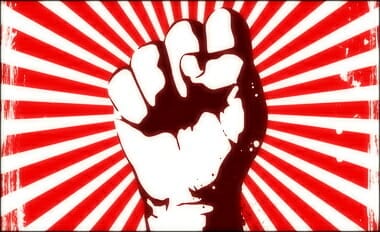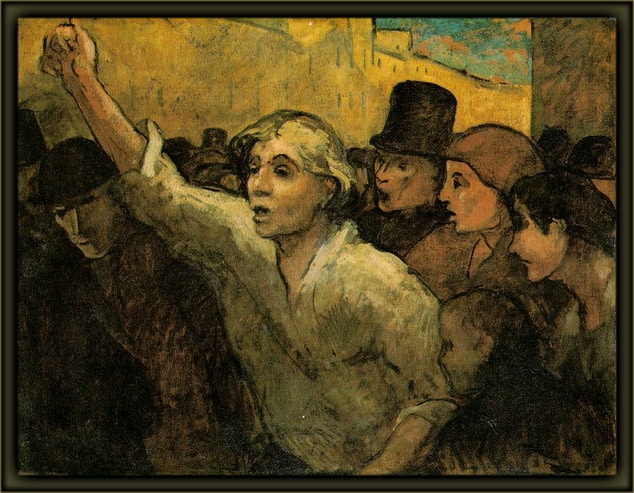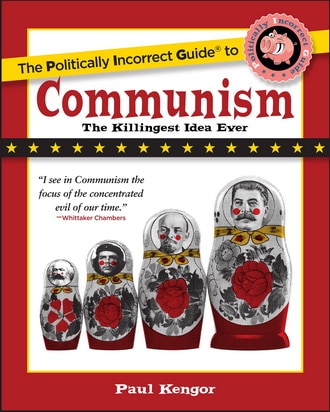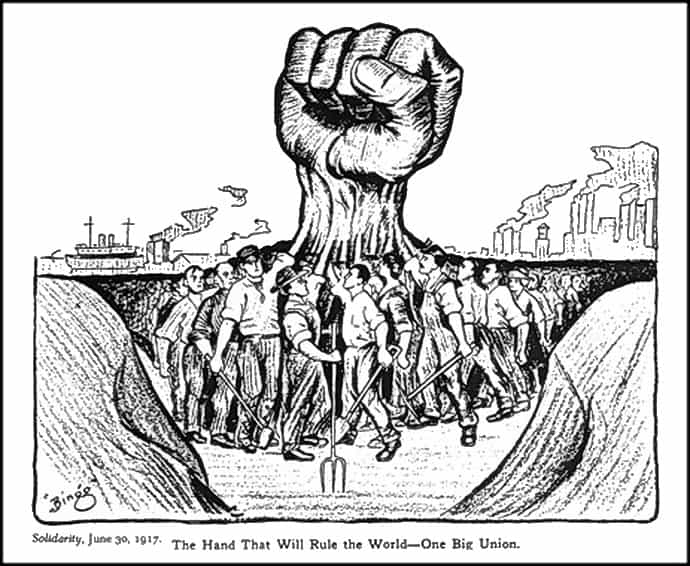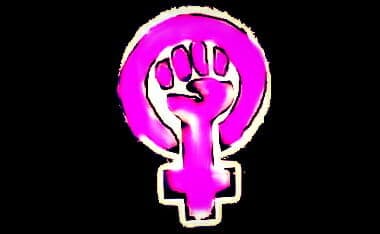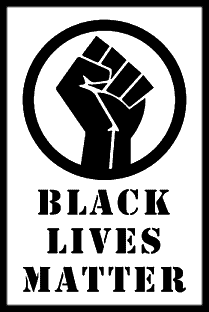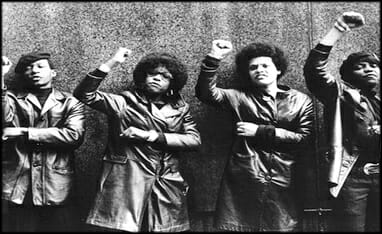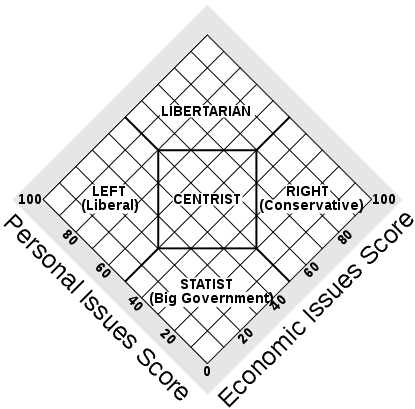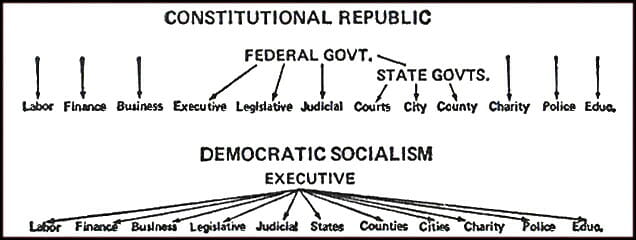Trade unions are a school of communism. — Vladimir Lenin
While I support the strike that may be hitting the movie industry — I myself am not in the union, nor, typically support unions — I can get behind this strike [if it happens]. Not only that, but, I fully understand what the union[s] are trying to say in their “solidarity.” THAT BEING SAID, I think that the union leaders using such a vile, disgusting communist/Marxist symbol is unfortunate.
(A side-note, many of the other stickers/graphics, especially the IATSE symbol, I find appealing)
Do they think that their members are stupid?
Not students of history?
I would say such a symbol divides rather than unites.
I bet a person responding to this post cannot find a single use of this symbol to represent a movement that does not have a direct connection to a Marxist, Communist, or Socialist.
Or violence.
In fact, the first time it was used in a revolution the guillotine was the end result. (More to come on more modern movements.)
This painting by Honoré Daumier of the French Revolution
of 1848 includes a possible early example of a “political
clenched fist,” according to curator Francesca Seravalle.
This battle is part of IATSE’s history, even if some try to deny it:
- Bioff’s successor, Richard F. Walsh, who served as president of IATSE from 1941 to 1974 without ever being indicted, was overshadowed by Roy Brewer, the alpha personality who came to town in 1945 as IATSE’s international representative. He had two missions: to maintain IATSE’s hammerlock on Hollywood labor and to purge the union ranks of any communist influence. (source)
While this site and the IATSE site tries to downplay the Communist activity and Reagan’s knowledge of it, here is some history, which often times is a bitch!
…In the early-morning hours, even before the sun peeked over the east hills, thousands of picketers showed up at Warner Brothers. They were vocal and angry. Hollywood had seen strikes before, but nothing quite like this.
The strike had been called by a ruddy-faced ex-boxer named Herb Sorrell, head of the Conference of Studio Unions (CSU), who was prepared to get rough. “There may be men hurt, there may be men killed before this is over, but we are in no mood to be pushed around anymore,” he warned. For good measure, he had brought dozens of tough guys (“sluggers,” he called them) in from San Francisco, just in case.
Herb Sorrell had come up the hard way, beginning work at the age of 12, laboring in an Oakland sewer-pipe factory for 11 hours a day. He had cut his teeth in the Bay Area labor movement under the leadership of Harry Bridges, the wiry leader of the International Longshoremen’s and Warehousemen’s Union. Bridges, according to Soviet archives, was also a secret member of the Communist Party and a regular contact for Soviet intelligence.
Sorrell had joined the party in the 1930s, and under Bridges’ guidance he had led two violent strikes in the Bay Area. Both strikes, he later admitted, were secretly funded by the Communists, and this time he was secretly receiving money from the National Executive Council of the Communist Party. Sorrell was a member of more than 20 Communist Party front organizations and had pushed hard for the American Federation of Labor to affiliate with the Soviet-run World Federation of Trade Unions. (AFL leaders refused on the grounds that it was simply a front group.)
The studio strike Sorrell organized in 1946 was no ordinary labor action. It was ostensibly called because of worker concerns, but Sorrell saw it as an opportunity to gain control over all the major unions in Hollywood. As he bragged in the early days of the action, “When it ends up, there’ll be only one man running labor in Hollywood, and that man will be me!”
The stakes were high. If Sorrell succeeded, the Communists believed, they could run Hollywood. As the party newspaper the People’s Daily World put it candidly, “Hollywood is often called the land of Make-Believe, but there is nothing make-believe about the Battle of Hollywood being waged today. In the front lines of this battle, at the studio gates, stand the thousands of locked-out film workers; behind the studio gates sit the overlords of Hollywood, [who] refuse even to negotiate with the workers. … The prize will be the complete control of the greatest medium of communication in history.” To underscore the value of this victory, the paper quoted Lenin: “Of all the arts, the cinema is the most important.”
The Communist Party had been active in Hollywood since 1935, when a secret directive was issued by CPUSA (Communist Party of the U.S.A.) headquarters in New York calling for the infiltration of Hollywood’s labor unions. The party believed that by doing so they could influence the type of pictures being produced. The directive also instructed party members to take leadership positions in the so-called intellectual groups in Hollywood, which were composed of directors, writers and performers.
To carry out the plan, CPUSA sent party activist Stanley Lawrence, a tall, bespectacled ex-cabdriver. Quietly and methodically he began developing secret cells that included Hollywood performers, writers and technicians. His actions were handled with great sensitivity… (source)
As an aside, two books I read many years ago which I recommend is titled,
- The Secret World of American Communism;
- and, The Soviet World of American Communism.
If someone is not familiar with the influence of communism of trade unions, you will when you finish these two books.
Stalin’s Hollywood Stooges
Few parts of history have been rewritten by liberals quite like the story of the communists who penetrated the American film industry. The latest research, particularly by Larry Ceplair, Steven Englund, and Allan Ryskind, shows that there were two to three hundred communists operating in Hollywood in the late 1940s, always under concealment. Indisputably guilty were the screenwriters who made up the so-called Hollywood Ten. They were all card-carrying members of the Communist Party.
These comrades literally swore themselves to Stalin’s Kremlin. Several of them followed Stalin even after the signing of the Hitler-Stalin Pact in 1939. Thus Allan Ryskind, son of Morrie Ryskind, an anti-communist screenwriter of the era, calls these dutiful comrades “Agents of Stalin, Allies of Hitler.” Here are the Ten, along with the Communist Party card numbers of each:
John Howard Lawson: 47275.
Dalton Trumbo: 47187.
Albert Maltz: 47196.
Alvah Bessie: 47279.
Samuel Ornitz: 47181.
Herbert Biberman: 47267.
Edward Dmytryk: 46859. (He had two additional numbers on other cards.)
Adrian Scott: 47200. (He had an additional number.)
Ring Lardner Jr.: 47180.
Lester Cole: 47226.35
Communists knew that the film industry could be tremendously useful for propagating communist propaganda. Vladimir Lenin said that “of all the arts, for us the most important is cinema.” Grigory Zinoviev, head of the Soviet Comintern, ordered that motion pictures “must become a mighty weapon of communist propaganda and for the enlightening of the widest working masses.” In March 1928, the Soviets held their first Party Conference on Cinema.36
35. Allan Ryskind, Hollywood Traitors: Blacklisted Screenwriters—Agenls of Stalin, Allies of Hitler (Washington, DC: Regnery, 2015); Larry Ceplair and Steven Englund, The Inquisition in Hollywood: Politics in the Film Community, 1930-60 (Urbana and Chicago: University of Illinois Press, 2003).
36. Anna M. Lawton, The Red Screen (London: Routledge, 2002), p. 58.
Paul Kengor, The Politically Incorrect Guide to Socialism (The Politically Incorrect Guides) (Washington, DC: Regnery Publishing, 2017), 77-78.
Some examples of this symbol used by radical organizations to follow shortly.
THE GUARDIAN has this interesting note regarding the “Clenched Fist”
The clenched fist was first used by the communists in the Spanish civil war, as a counterpoint to the open-palmed Roman salute adopted by the fascists.[END NOTE] The clenched fist symbolises strength and unity – fingers which are individually fragile can together make a powerful fist. It became a symbol of communism and was co-opted to many revolutionary causes, most potently the civil rights struggle in the US and opposition to colonialism in the third world. But it is now so freighted with historical associations – the murky faction fighting on the left in the Spanish civil war, the perversion of communism in the Soviet Union, the tyrannies that emerged in post-colonial Africa – that, according to the socialist historian Sheila Rowbotham, it has become a double-edged symbol. “Even in the 1960s,” she says, “my generation used it slightly self-consciously. It was connected to communism and post-’56, [when the Soviet army suppressed the Hungarian uprising] using it made you feel slightly uneasy.”
She also doubts whether anarchists and anti-globalisation protesters today would find its overtones of power and enclosedness attractive. “It symbolises power clenched within the group, and since the 1960s the left has felt ambiguous about the exercise of power.
PLEASE KEEP IN MIND that when this symbol from Communist/Marxist global movements was adopted… Communism was just getting started in the killing of a good chunk of humanity.
- “We have no compassion and we ask no compassion from you. When our turn comes, we shall not make excuses for the terror.” — Karl Marx and Friedrich Engels “Suppression of the Neue Rheinische Zeitung”, Neue Rheinische Zeitung, May 19, 1849 (RPT)
The Third Reich killed 12-million people, obviously no organization would use symbols tied to Hitler. But in 100-years, Communism in the name of Marxist Ideology and Dialectical Materialism killed at least 160-million people. So why on God’s Green Earth would anyone use it’s symbol?? They [Communists] killed more people in 100-years than all religions in all the centuries before it.
The aim of the IWW was to unite in one body all skilled and unskilled workers for the purpose of overthrowing capitalism and rebuilding society on a socialistic basis. Its methods were direct action, propaganda, the boycott, and the strike; it was opposed to sabotage, to arbitration or collective bargaining, and to political affiliation and intervention. The organization spread to Canada and Australia and in a very small way to Europe, but its main activities were confined to the United States. It was especially strong in the lumber camps of the Northwest, among dockworkers in port cities, in the wheat fields of the central states, and in textile and mining areas. Of the 150 strikes conducted by the IWW, the most notable occurred at Goldfield, Nev. (miners, 1906–7); at Lawrence, Mass. (textile workers, 1912); at Paterson, N.J. (silk workers, 1913); in the Mesabi range, Minn. (iron miners, 1916); in the lumber camps of the Northwest (1917); at Seattle (general strike, 1919); and in Colorado (miners, 1927–28).
The WASHINGTON TIMES notes the change of the current ethos of unions being different than the Cold War:
labor leader Andy Stern has seen the future. There’s no freedom there, but he’s OK with that. Mr. Stern, a former president of the Service Employees International Union (SEIU), recently returned from a trip to China, where he had the opportunity to meet with “high-ranking” government officials, who outlined for the former labor leader the authoritarian regime’s long-term economic plan.
Mr. Stern was so enamored with what he saw in the Middle Kingdom that he praised the communist country’s state-planned economy in the pages of the Wall Street Journal and urged the United States to embark on a similar path. Among the more revolting passages of Mr. Stern’s love letter to Leninism:
“The conservative-preferred, free-market fundamentalist, shareholder-only model – so successful in the 20th century – is being thrown onto the trash heap of history in the 21st century. In an era when countries need to become economic teams, Team USA’s results – a jobless decade, 30 years of flat median wages, a trade deficit, a shrinking middle class and phenomenal gains in wealth but only for the top 1 percent – are pathetic. This should motivate leaders to rethink, rather than double down on an empirically failing free-market extremism.”
That a labor leader would proclaim love for freedom an extreme view should come as no surprise – the history of labor unions has been intimately entwined with the history of global communism. As the influential Dutch astronomer and Marxist theorist Anton Pannekoek wrote in his 1908 treatise, “The Labor Movement and Socialism,” “The object of the labor movement is to increase the strength of the proletariat to the point at which it can conquer the organized force of the bourgeoisie and thus establish its own supremacy.”
[….]
The sad thing is, for a time in the 20th century, American unions turned from this seedy past to become defenders of economic freedom. As Ivan Osorio, labor expert at the Competitive Enterprise Institute, notes, “During the Cold War, the AFL-CIO, Teamsters and most major U.S. labor unions were staunchly anti-communist. In fact, the AFL-CIO under Lane Kirkland worked closely with the Reagan administration to aid the Solidarity movement in Poland.” Unfortunately, our 21st-century unions seem to be slipping back to their traditional socialist mores and tendencies as they decline in popularity. In 2010, the union membership rate was 11.9 percent, down from 20.1 percent in 1983, according to the Bureau of Labor Statistics.
Unions today loathe freedom, as Andy Stern demonstrates in his Wall Street Journal column, because unions require unfree markets in order to thrive. They love big government because unions require the government to guarantee their monopolies on labor. And it is precisely those features of unions that have contributed to their increasing unpopularity in the United States, where citizens are becoming wise to the corrupt conspiracy between unions and government to extinguish their liberties.
In a February interview with The Washington Post’s Ezra Klein, Mr. Stern lamented the decline of organized labor’s power and influence and waxed nostalgic about the movement’s early days: “We had to do sit-down strikes and various other things. We had socialist and communist tendencies. We grew up, to speak in Marxist terms, in a world with a lot more class struggle … but it’s not viewed through that light anymore.”
Yeah, poor unions. If we were all a little more Marxist, maybe they wouldn’t be having such a tough time of it.
Some Examples
SPANISH CIVIL WAR (WIKI HISTORY)
The origin of the raised fist as either a symbol or gesture is unclear. Its use in trade unionism, anarchism, and the labor movement had begun by the 1910s. William “Big Bill” Haywood, a founding member of the Industrial Workers of the World, used the metaphor of a fist as something greater than the sum of its parts during a speech at the 1913 Paterson silk strike. Journalist and socialist activist John Reed described hearing a similar description from a participant in the strike A large raised fist rising from a crowd of striking workers was used to promote a mass strike in Budapest in 1912. In the United States, clenched fist was described by the magazine Mother Earth as “symbolical of the social revolution” in 1914.
The use of the fist as a salute by communists and antifascists is first evidenced in 1924, when it was adopted for the Communist Party of Germany’s Roter Frontkämpferbund (“Alliance of Red Front-Fighters”). In reaction, the Nazi Party adopted the well-known Roman salute two years later. The gesture of the raised fist was apparently known in the United States as well, and is seen in a photograph from a May Day march in New York City in 1936. It is perhaps best known in this era from its use during the Spanish Civil War of 1936–1939, as a greeting by the Republican faction, and known as the “Popular Front salute” or the “anti-fascist salute”
The graphic symbol was popularised in 1948 by Taller de Gráfica Popular, a print shop in Mexico that used art to advance revolutionary social causes. Its use spread through the United States in the 1960s after artist and activist Frank Cieciorka produced a simplified version for the Student Nonviolent Coordinating Committee: this version was subsequently used by Students for a Democratic Society and the Black Power movement.
The raised right fist was frequently used in posters produced during the May 1968 revolt in France, such as La Lutte continue, depicting a factory chimney topped with a clenched fist.
A raised right fist icon appears prominently as a feminist symbol on the covers of two major books by Robin Morgan, Sisterhood is Powerful, published in 1970, and Sisterhood Is Forever, in 2003. The symbol had been popularised in the feminist movement during the Miss America protest in 1968 which Morgan co-organised.
A raised fist incorporates the outline of the state of Wisconsin, as designed in 2011, for union protests against the state rescinding collective bargaining.
GEORGE ORWELL (SPANISH WAR CONNECTION)
The first printed versions came in the early 1900s, with cartoons like this one published in 1917 by the Industrial Workers of the World.
The symbol was soon picked up by violent communist factions as well, such as those in the Spanish Civil War.
One 1936 poster from the communist-aligned Unified Socialist Party of Catalonia (PSUC) depicts four fists raised in front of a Soviet flag.
Much of the fighting in the war involved leftist groups fighting each other.
George Orwell, then a young British socialist who traveled to Spain to fight against fascists, soon found that the communist PSUC, a group behind the poster, denounced his own group as “fascist.”
“When the Communists gained control … and began to hunt down [my socialist faction] … we were very lucky to get out of Spain alive,” Orwell reported.
Orwell credited his experience in Spain with helping inspire his classics “1984” and “Animal Farm,” which took aim at communist totalitarian propaganda for its hypocrisies and lies. (source)
Robin Morgan organized the September 1968 protest at the Miss America Pageant in Atlantic City, the first major public action of contemporary feminism. That year she co-founded W.I.T.C.H., a radical feminist group employing guerrilla-theater actions to call attention to sexism. Morgan designed the universal logo of the women’s movement, the woman’s symbol centered with a raised fist. [….] she Co-founder (with the late Simone de Beauvoir) and President of The Sisterhood Is Global Institute, the first international feminist think tank, and co-founder (with Jane Fonda and Gloria Steinem).
TO WIT…
ROBIN MORGAN
The true radicalism of the feminist movement, and its connection to those thinkers discussed above (Marx, Lenin, Gramsci, and Marcuse), is evident in second-wave writings. Morgan describes the feminists as “revolutionaries.” Firestone explicitly cites Marx and Engels as important to the feminist project, claiming that “for feminist revolution we shall need an analysis of the dynamics of sex war as comprehensive as the Marx-Engels analysis of class antagonism was for the economic revolution…. In creating such an analysis we can learn a lot from Marx and Engels.”
The ultimate goal is to instigate a social revolution analogous to the economic revolution articulated by Marx and Engels: “Unless revolution uproots the basic social organization,” writes Firestone, “the biological family…the tapeworm of exploitation will never be annihilated.” This connection between Marxist theory and social revolution continues in the thought of the American Left today. Recently The Nation ran an interview with feminist theorist Sophie Lewis on her new book. The title of the interview was “Want to Dismantle Capitalism? Abolish the Family.” (source)
GLORIA STEINEM
- “Overthrowing capitalism is too small for us. We must overthrow the whole Fucking patriarchy” (Detroit Free Press, April 15, 1974)
- In 1977, in Houston, Gloria Steinem said, “For the sake of those who wish to live in equal partnership, we have to abolish and reform the institution of legal marriage.”
- “When I was in college it was the McCarthy era and that made me a Marxist. Nothing was more clear than if Joseph McCarthy was against Marxists then I should be a Marxist… .” (Susan Mitchell, Icons, Saints and Divas, Sydney, HarperCollins, 1997, p. 130)
- Later, Gloria joined the Democratic Socialists of America.
JANE FONDA
Fonda was married to French director Roger Vadim from 1965 to 1973, and it was while living in France that she was introduced to French communists who would initiate her into political activism. Together she and Vadim had a daughter, Vanessa, so named because Fonda admired actress Vanessa Redgrave’s radical politics. Fonda became pregnant by activist Tom Hayden in 1972, and the two were married in 1973 (they would divorce in 1990). Fonda and Hayden named their newborn son Troy (originally spelled “Troi”) after a Viet Cong hero, Nguyen Van Troi, who was executed by the South Vietnamese government after attempting to assassinate Secretary of Defense Robert McNamara in 1963. (Fonda’s third marriage, to television mogul Ted Turner, would last from 1991 to 2001.)
Fonda’s affinity for communism served as a backdrop for her intense anti-Vietnam War activities. By 1970 she was telling American college students: “If you understood what communism was, you would hope, you would pray on your knees that we would some day become communist…. I, a socialist, think that we should strive toward a socialist society, all the way to communism.” The dual villains of Southeast Asian conflicts were, in her view, “U.S. imperialism” and “a white man’s racist aggression.”
In April 1970, Fonda and actor Donald Sutherland formed “FTA” (which meant, depending upon the source, either “Free the Army” or “F*ck the Army”), an anti-war, quasi-USO road show billed as “political vaudeville” that toured military towns along the West Coast and throughout the Pacific.
Fonda also worked with Vietnam Veterans Against the War (VVAW), serving as Honorary National Coordinator for a 1970 rally which that group organized in Valley Forge, Pennsylvania. Vietnam veteran and future Democratic presidential nominee John Kerry was also involved in organizing the rally (he and Fonda were photographed sitting near each other at the event).
On November 3, 1970 Fonda began a tour of college campuses to raise funds for VVAW. (On that same date, Fonda was arrested for allegedly kicking a U.S. Customs agent; charges were later dropped. In the police mug shot, her raised left hand is clenched in a “Black Power” or “Power to the People” salute). (source)
Not only is BLM a Marxist organization, who’s founders themselves are Marxists and carry water for the communist governments in China and Cuba, but their symbol is found splattered on many a Democrat’s car. Adding to the division even lately in the use of the symbol. After talking to many of the construction guys on the studio lots… many are Republicans as well, who I assume view the symbol with some ire.
…The symbol of a clenched, raised fist is ascendant among Black Lives Matter protesters, Antifa rioters and other political left-wingers.
But critics of the symbol note its origin and long use with communist movements – a history so fraught that, until recently, many left-wing protesters hesitated to use the iconic image.
“It is a symbol used by movements that establish oppressive systems, as every system established along Marxist lines has been,” Murray Bessette, a former professor of government at Morehead State University and now with the Victims of Communism Memorial Foundation, told Fox News.
“The raised fist is primarily used by organizations and movements that are heavily influenced by Marxism broadly understood,” Bessette explained.
“The common thread is [an] understanding of all social, economic and political relations as a contestation for power between a class of oppressors (i.a., rich, White, heterosexual, male) and a class of oppressed,” he said…. (source)
The group was at the forefront of demonstrations against police actions across the country and became a national rallying cry. The organization’s radical politics, though, have been largely ignored, even though its leaders haven’t been afraid to voice them.
Cullors in particular was open about her political ideology, calling herself “a trained Marxist” in an interview with Democracy Now!
“The first thing, I think, is that we actually do have an ideological frame,” she said. “Myself and Alicia in particular are trained organizers. We are trained Marxists. We are super-versed on, sort of, ideological theories. And I think that what we really tried to do is build a movement that could be utilized by many, many black folk.”
What exactly does it mean to be a “trained Marxist?” For years, Cullors was mentored by Eric Mann, a member of the 1960s radical groups Students for a Democratic Society and its more violent splinter group The Weather Underground.
In 1969, the U.S. Government declared the Weather Underground a domestic terror organization after it declared “a state of war against the United States” and started launching “Days of Rage” riots and bombing attacks against the U.S. Capitol in 1971, the Pentagon a year later, and the State Department building in 1975.
Fortunately, no one was ever killed in any of the Underground’s attacks, but three members died when one of their explosives accidentally detonated in their hideout in New York.
Cullors said in her memoir, “When They Call You a Terrorist: A Black Lives Matter Memoir,” that Mann taught her from an early age to use the organizing and protest tactics he honed during his time as a campus radical.
Using this teaching, her self-described “first political home” was the Labor/Community Strategy Center, whose organizing principles center “focus on Black and Latino communities with deep historical ties to the long history of anti-colonial, anti-imperialist, pro-communist resistance to the U.S. empire.”
According to its website, the group is openly Marxist, as it appreciates the work of “Black communists” within the U.S. Communist Party as well as “the Black Panther Party, the American Indian Movement, Young Lords, Brown Berets, and the great revolutionary rainbow experiments of the 1970s.”
Cullors’ Black Lives Matter co-founder, Opal Tometi, is similarly radical, as she has spent years championing the disastrous Socialist Revolution in Venzuela, writing of dictator Nicolas Maduro’s regime, “In these last 17 years, we have witnessed the Bolivarian Revolution champion participatory democracy and construct a fair, transparent election system recognized as among the best in the world.”
This embrace of socialism is evident in the mission statement of Black Lives Matter, which explicitly states “We are a collective of liberators who believe in an inclusive and spacious movement. We also believe that in order to win and bring as many people with us along the way, we must move beyond the narrow nationalism that is all too prevalent in Black communities.”
What does such “nationalism” encompass? Apparently the nuclear family, which Black Lives Matter aims to destroy.
“We disrupt the Western-prescribed nuclear family structure requirement by supporting each other as extended families and ‘villages’ that collectively care for one another, especially our children, to the degree that mothers, parents, and children are comfortable,” the group says in a section of its website entitled “What We Believe.” (source)
BLM and it’s symbols have — at least in my mind — been connected with violent and downright racist calls to action:
…To this day, the Black Panther Party remains a controversial group. According to former Marxists radicals Peter Collier and David Horowitz in their book DESTRUCTIVE GENERATION, the Black Panthers “engaged widely in drug dealing, pimping, extortion, theft, assault, and homicide”. In 1969 alone, the time period of this movie, 348 Black Panther members were arrested for murder, armed robbery, rape, and burglary (Peter Collier and David Horowitz, DESTRUCTIVE GENERATION (Summit Books, 1989), page 164).
Hollywood is a business, and the people running Hollywood are in the business of selling things. At its best, Hollywood sells wholesome entertainment that the whole family can enjoy.
In World War II, Hollywood sold American, British and French patriotism as patriots from the United States, Great Britain and France fought together to defeat the terrible tyranny of Adolf Hitler’s National Socialist Party.
With JUDAS AND THE BLACK MESSIAH, however, Netflix and the movie’s writer, director and producer, Shaka King, who studied under radical black filmmaker Spike Lee, are selling violent Marxist revolution. Of course, Netflix, King and their comrades in the mass media of entertainment, including the “news” media, would like to mute the violent, radical nature of movies like JUDAS AND THE BLACL MESSIAH and of Marxist groups like the Black Panther Party.
To its credit, the movie does show Fred Hampton saying violent things like his exhortation to the crowd to kill all police officers. However, at the end of the movie, viewers are apparently supposed to be outraged and shocked that local and state police officers deliberately assassinated this radical socialist who had been publicly advocating their murder. The fact that the Hollywood Reporter ad for the movie uses an innocuous quote from “Chairman” Hampton in the movie about the power of the people, instead of his quote from Mao that “political power grows out of the barrel of a gun,” indicates just how deceitful the movie and the ad actually are…. (source)
I could go on, but the violent, radical use of the raised fist imagery angers [I imagine] many who love their union but hates the adopted use of such violent symbols. It causes in me a great hesitation to even speak highly of any cause — as good as it may be — when I see it used.
END NOTE
RPT CLIPS (source | source | source)
Both Fascism and Communisms are left-leaning ideologies. One is not “Right,” and one is not “Left.” The following graph includes all political models and better shows where the political beliefs lie e.g., left or right is the following (take note, this graph is from a book I do not support nor recommend… but these visual insights are very useful):
Let us look at what we are told is suppose to be the political landscape if it were to be put into a line graph.
Really this is misleading. For one, it doesn’t allow for anarchy, which is a form of governance (or lack thereof). Also, it places democracy in the center… as if this is what one should strive for, a sort of balance. (The most popular — college level graph — is wrong and misleading as well):
The following graph includes all political models and better shows where the political beliefs lie e.g., left or right is the following (take note, this graph is from a book I do not support nor recommend… but these visual insights are very useful):
In actuality, during WWII, fascism grew out of socialism, showing how close the ties were. I would argue that the New Left that comprises much of the Democratic Party today is fascistic, or, at least, of a closer stripe than any conservative could ever hope to be. I will end with a model comparing the two forms of governance that the two core values (conservatism/classical liberalism versus a socialist democracy) will produce. Before you view the below though, keep in mind that a few years back the ASA (American Socialist Association) on their own web site said that according to the voting record of United States Congressmen and Women, that 58 of them were social democrats. These are the same that put Hitler and Mussolini in power.
Which Do You Prefer?? Leftist Democrats want more government control, Conservative Republicans want less government control.
In this video, @ComicDaveSmith, rightfully, rains nuclear fire on a entirely unprepared progressive. pic.twitter.com/XoP1pFLkcT
— Article V Convention of States please (@philthatremains) September 10, 2021
Here is an extended quote from Dinesh D’Souza’s book, THE BIG LIE, detailing the easy switch from socialist leaders and unions to fascist — overnight:
…on March 23, 1919, one of the most famous socialists in Italy founded a new party, the Fasci di Combattimento, a term that means “fascist combat squad.” This was the first official fascist party and thus its founding represents the true birth of fascism. By the same token, this man was the first fascist. The term “fascism” can be traced back to 1914, when he founded the Fasci Rivoluzionari d’Azione Internazionalista, a political movement whose members called themselves fascisti or fascists.
In 1914, this founding father of fascism was, together with Vladimir Lenin of Russia, Rosa Luxemburg of Germany, and Antonio Gramsci of Italy, one of the best known Marxists in the world. His fellow Marxists and socialists recognized him as a great leader of socialism. His decision to become a fascist was controversial, yet he received congratulations from Lenin who continued to regard him as a faithful revolutionary socialist. And this is how he saw himself.
That same year, because of his support for Italian involvement in World War I, he would be expelled from the Italian Socialist Party for “heresy,” but this does not mean he ceased to be a socialist. It was common practice for socialist parties to expel dissenting fellow socialists for breaking on some fine point with the party line. This party reject insisted that he had been kicked out for making “a revision of socialism from the revolutionary point of view.” For the rest of his life—right until his lifeless body was displayed in a town square in Milan—he upheld the central tenets of socialism which he saw as best reflected in fascism.
Who, then, was this man? He was the future leader of fascist Italy, the one whom Italians called Il Duce, Benito Mussolini.
Mussolini’s socialist credentials were impeccable. He had been raised in a socialist family and made a public declaration in 1901, at the age of eighteen, of his convictions. By twenty-one, he was an orthodox Marxist familiar not only with the writings of Marx and Engels but also of many of the most influential German, Italian, and French Marxists of the fin de siecle period. Like other orthodox Marxists, Mussolini rejected religious faith and authored anti-Catholic pamphlets repudiating his native Catholicism.
Mussolini embarked on an active career as a writer, editor, and political organizer. Exiled to Switzerland between 1902 and 1904, he collaborated with the Italian Socialist Party weekly issued there and also wrote for Il Proletario, a socialist weekly published in New York. In 1909 Mussolini made another foreign sojourn to Trento—then part of Austria-Hungary—where he worked for the socialist party and edited its newspaper. Returning the next year to his hometown of Forli, he edited the weekly socialist publication La Lotta di Classe (The Class War). He wrote so widely on Marxism, socialist theory, and contemporary politics that his output now fills seven volumes.
Mussolini wasn’t just an intellectual; he organized workers’ strikes on behalf of the socialist movement both inside and outside of Italy and was twice jailed for his activism. In 1912, Mussolini was recognized as a socialist leader at the Socialist Congress at Reggio Emilia and was appointed to the Italian Socialist Party’s board of directors. That same year, at the age of twenty-nine, he became editor of Avanti!, the official publication of the party.
From the point of view of the progressive narrative—a narrative I began to challenge in the previous chapter—Mussolini’s shift from Marxian socialism to fascism must come as a huge surprise. In the progressive paradigm, Marxian socialism is the left end of the spectrum and fascism is the right end of the spectrum. Progressive incredulity becomes even greater when we see that Mussolini wasn’t just any socialist; he was the recognized head of the socialist movement in Italy. Moreover, he didn’t just climb aboard the fascist bandwagon; he created it.
Today we think of fascism’s most famous representative as Adolf Hitler. Yet as I mentioned earlier, Hitler didn’t consider himself a fascist. Rather, he saw himself as a National Socialist. The two ideologies are related in that they are both based on collectivism and centralized state power. They emerge, one might say, from a common point of origin. Yet they are also distinct; fascism, for instance, had no intrinsic connection with anti-Semitism in the way that National Socialism did.
In any event, Hitler was an obscure local organizer in Germany when Mussolini came to power and, following his famous March on Rome, established the world’s first fascist regime in Italy in 1922. Hitler greatly admired Mussolini and aspired to become like him. Mussolini, Hitler said, was “the leading statesman in the world, to whom none may even remotely compare himself.” Hitler modeled his failed Munich Putsch in November 1923 on Mussolini’s successful March on Rome.
When Hitler first came to power he kept a bust of Mussolini in his office and one German observer termed him “Germany’s Mussolini.” Yet later, when the two men first met, Mussolini was not very impressed by Hitler. Mussolini became more respectful after 1939 when Hitler conquered Austria, Poland, Czechoslovakia, Belgium, Norway, and France. Hitler continued to uphold Mussolini as “that unparalleled statesman” and “one of the Caesars” and confessed that without Italian fascism there would not have been a German National Socialism: “The brown shirt would probably not have existed without the black shirt.”
Hitler was, like Mussolini, a man of the Left. Hitler too was a socialist and a labor leader who founded the German Socialist Workers’ Party with a platform very similar to that of Mussolini’s fascist party. Yet Hitler came to power in the 1930s while Mussolini ruled through most of the 1920s. Mussolini was, during those years, much more famous than Hitler. He was recognized as the founding father of fascism. So any account of the origin of fascism must focus not on Hitler but on Mussolini. Mussolini is the original and prototypical fascist.
From Socialism to Fascism
So how—to return to the progressive paradigm—do progressives account for Mussolini’s conversion from socialism to fascism, or more precisely for Mussolini’s simultaneous embrace of both? The problem is further deepened by the fact that Mussolini was not alone. Hundreds of leading socialists, initially in Italy but subsequently in Germany, France, and other countries, also became fascists. In fact, I will go further to say that all the leading figures in the founding of fascism were men of the Left. “The first fascists,” Anthony James Gregor tells us, “were almost all Marxists.”
I will cite a few examples. Jean Allemane, famous for his role in the Dreyfus case, one of the great figures of French socialism, became a fascist later in life. So did the socialist Georges Valois. Marcel Deat, the founder of the Parti Socialiste de France, eventually quit and started a pro-fascist party in 1936. Later, he became a Nazi collaborator during the Vichy regimeVacques Doriot a French communist, moved his Parti Populaire Francais into the fascist camp.
The Belgian socialist theoretician Henri de Man transitioned to becoming a fascist theoretician. In England. Oswald Mosley, a socialist and Labor Party Member of Parliament, eventually broke with the Labor Party because he found it insufficiently radical. He later founded the British Union of Fascists and became the country’s leading Nazi sympathizer. In Germany, the socialist playwright Gerhart Hauptmann embraced Hitler and produced plays during the Third Reich. After the war, he became a communist and staged his productions in Soviet-dominated East Berlin
In Italy, philosopher Giovanni Gentile moved from Marxism to fascism, as did a host of Italian labor organizers: Ottavio Dinale, Tullio Masotti, Carlo Silvestri, and Umberto Pasella. The socialist writer Agostino Lanzillo joined Mussolini’s parliament as a member of the fascist party Nicola Bombacci, one of the founders of the Italian Communist Party, became Mussolini’s top adviser in Salo. Gentile’s disciple Ugo Spirito, who also served Mussolini at Salo, moved from Marxism to fascism and then back to Marxism. Like Hauptmann, Spirito became a communist sympathizer after World War II and called for a new “synthesis” between communism and fascism.
Others who made the same journey from socialism to fascism will be named in this chapter, and one thing that will become very clear is that these are not “conversion” stories. These men didn’t “switch” from socialism to fascism. Rather, they became fascists in the same way that Russian socialists became Leninist Bolsheviks. Like their Russian counterparts, these socialists believed themselves to be growing into fascism, maturing into fascism, because they saw fascism as the most well thought out, practical form of socialism for the new century.
Progressivism simply cannot account for the easy traffic from socialism to fascism. Consequently, progressives typically maintain complete silence about this whole historical relationship which is deeply embarrassing to them. In all the articles comparing Trump to Mussolini I searched in vain for references to Mussolini’s erstwhile Marxism and lifelong attachment to socialism. Either from ignorance or from design, these references are missing.
Progressive biographical accounts that cannot avoid Mussolini’s socialist past nevertheless turn around and accuse Mussolini—as the Socialist Party of Italy did in 1914—of “selling out” to fascism for money and power. Other accounts contend that whatever Mussolini’s original convictions, the very fact that his fascists later battled the Marxists and traditional socialists clearly shows that Mussolini did not remain a socialist or a man of the Left.
But these explanations make no sense. When Mussolini “sold out” he became an outcast. He had neither money nor power. Nor did any of the first fascists embrace fascism for this reason. Rather, they became fascists because they saw fascism as the only way to rescue socialism and make it viable. In other words, their defection was within socialism—they sought to create a new type of socialism that would actually draw a mass following and produce the workers’ revolution that Marx anticipated and hoped for.
Vicious fights among socialist and leftist factions are a recognized feature of the history of socialism. In Russia, for example, there were bloody confrontations between the rival Bolsheviks and Mensheviks. Later the Bolsheviks split into Leninists and Trotskyites, and Trotsky ended up dead on Lenin’s orders. These were all men of the Left. What these bloody rivalries prove is that the worst splits and conflicts sometimes arise among people who are ideologically very similar and differ on relatively small—though not small to them—points of doctrine.
In this chapter I will trace the development of fascism by showing precisely how it grew out of a doctrinal division within the community of Marxian socialists. In short, I will prove that fascism is exclusively a product of the Left. This is not a case of leftists who moved right. On the contrary, the fascists were on the left end of the socialist movement. They saw themselves not as jettisoning Marxism but as saving it from obsolescence. From their perspective, Marxism and socialism were too inert and needed to be adjusted leftward. In other words, they viewed fascism as more revolutionary than traditional socialism.
[….]
Mussolini didn’t believe in race and he wasn’t initially a nationalist; rather, he was a revolutionary syndicalist. The term syndicalism refers to the associations or syndicates to which workers belonged. These were autonomous workers organizations that resembled unions, but they were not unions because the syndicates were organized regionally rather than by corporation or occupation. As dedicated Marxists, the revolutionary syndicalists agreed with Marx that class associations were primary, and that they must be the organizing principle of socialist revolution.
Very much in keeping with this class emphasis that was so central to Marx, the syndicalists, strongly influenced by Sorel, sought to rally the labor syndicates through a general strike that would overthrow the ruling class and establish socialism in Italy. This is what made them “revolutionary.” They intended to foment revolution, not wait for it to happen. They were considered the smartest, most dedicated people in the Italian Socialist Party and they occupied the left wing of the party.
The big names in revolutionary syndicalism were Giuseppe Prezzolini, Angelo 0. Olivetti, Arturo Labriola, Filippo Corridoni, Paolo Orano, Michele Bianchi, and Sergio Panunzio. Most of them were writers or labor organizers. All of them were socialists, and shortly all of them would be camelascists, even though Labriola opposed Mussolini’s regime when it came to power and Corridoni, who was killed in World War I, didn’t live to see it.
Mussolini was their acknowledged leader. He knew them well and conspired with them at meetings and rallies. He read their books and articles and published in their magazines like the Avanguardia Socialista, founded by Laboriola, which was the leading journal of syndicalist thought. Mussolini also reviewed and published the leading syndicalists in his own socialist publications.
Like all revolutionary socialists, the syndicalists had little faith in democratic parliamentary procedures and, consistent with Sorel and Lenin, they sought a charismatic leader who would inspire the workers to action. Mussolini, more than anyone else, fit their prescription. Mussolini was the one who led the syndicalists into a union with the nationalists in order to form the new socialist hybrid called fascism in Italy and (with some modifications) National Socialism in Germany.
The syndicalists organized three general strikes in Italy in 1904, 1911, and 1913. Mussolini supported the strikes. The 1904 strike began in Milan and spread across the country. Five million workers walked off their jobs. The nation was paralyzed: there was no public transportation, and no one could buy anything. Even so, the strike ended without causing either the fall of the government or the installation of socialism.
- Dinesh D’Souza, The Big Lie: Exposing the NAZI Roots of the American Left (Washington, DC: Regnery Publishing, 2017), 65-70, 82-83.
- “Everything I have said and done in these last years is relativism by intuition…. If relativism signifies contempt for fixed categories and men who claim to be bearers of an objective, immortal truth… then there is nothing more relativistic than fascistic attitudes and activity…. From the fact that all ideologies are of equal value, that all ideologies are mere fictions, the modern relativist infers that everybody has the right to create for himself his own ideology and to attempt to enforce it with all the energy of which he is capable.” [i.e., violence, ostracizing, and government coercion]
Mussolini, Diuturna (1924) pp. 374-77, quoted in A Refutation of Moral Relativism: Interviews with an Absolutist (Ignatius Press; 1999), by Peter Kreeft, p. 18.
TO WIT…
